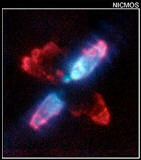![]()
![]()
The Near Infrared Camera and Multi-Object Spectrometer (NICMOS) is an instrument that allows Hubble to make infrared images and spectroscopic observations of stellar phenomena. NICMOS detects light with wavelengths between 0.8 and 2.5 micrometers, which is longer than the human eye can detect. The sensitive arrays, made of the elements mercury, cadmium, and tellurium, which comprise the infrared detectors in NICMOS, must operate at very cold temperatures. NICMOS keeps its detectors cold inside a cryogenic dewar (a thermally insulated container much like a thermos bottle) containing frozen nitrogen ice. The dewar keeps the detectors cool for years, much longer than any previous space experiment. NICMOS is Hubble's first cryogenic instrument.
This image was captured by Hubble's NICMOS. It is of the Egg Nebula which is also known as CRL 2688. A nebula is a cloud of glowing gas in space, lit up by hot young stars within it. The image is of the nebula as it appears in infrared light. Since infrared light is invisible to humans, the NICMOS image has been assigned colours to distinguish different wavelengths: blue corresponds to starlight reflected by dust particles, and red corresponds to heat radiation emitted by hot molecular hydrogen.
